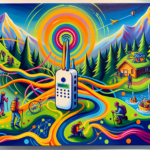Choosing the right technology for your project can be a daunting task. Two notable solutions in the wireless IoT space are Meshtastic and SenseCap, each offering unique features and capabilities. Understanding the differences between these two technologies can help you make an informed decision on which might be the best choice for your project. In this blog post, we’ll explore the key features, use cases, and advantages of Meshtastic and SenseCap to help you determine which solution best fits your needs.
Understanding Meshtastic
What is Meshtastic?
Meshtastic is an open-source project that enables the creation of mesh networks using LoRa (Long Range) radio technology. It is designed to facilitate long-range, low-power communication without relying on traditional cellular or Wi-Fi networks. Meshtastic devices can send and receive messages, share GPS coordinates, and monitor environmental conditions, making them ideal for remote areas, outdoor activities, and emergency situations.
Key Features of Meshtastic
- Long-Range Communication: Meshtastic leverages LoRa technology to achieve communication ranges of several kilometers, making it suitable for applications where traditional networks are unavailable.
- Low Power Consumption: Designed for battery-powered applications, Meshtastic devices consume minimal power, allowing for extended operation in remote locations.
- Mesh Networking: Each Meshtastic device acts as a node in a mesh network, enabling decentralized communication and message relaying over extended distances.
- Open-Source Community: As an open-source project, Meshtastic benefits from a collaborative community of developers and users who contribute to its growth and improvement.
- GPS Integration: Many Meshtastic devices come with integrated GPS modules, allowing users to share their locations with other nodes in the network.
Use Cases for Meshtastic
- Outdoor Adventures: Ideal for hikers, campers, and explorers who need reliable communication in remote areas.
- Emergency Response: Provides a resilient communication solution for first responders in disaster scenarios.
- Event Coordination: Facilitates communication between organizers and participants in areas with limited network coverage.
- Environmental Monitoring: Supports data collection and transmission from remote sensors for real-time monitoring.
Understanding SenseCraft (SenseCap)
What is SenseCraft/SenseCap?
SenseCap is a line of IoT products developed by Seeed Studio. These items are designed to provide reliable and scalable solutions for environmental monitoring and data collection. SenseCap devices are equipped with various sensors and connectivity options, making them suitable for a wide range of IoT applications, including smart agriculture, industrial monitoring, and environmental research.
Key Features of SenseCraft / SenseCap
- Comprehensive Sensor Integration: SenseCap devices come with a variety of sensors, including temperature, humidity, CO2, and more, allowing for comprehensive environmental monitoring.
- LoRaWAN Connectivity: SenseCap devices use LoRaWAN technology for long-range, low-power communication, enabling data transmission over extended distances.
- Cloud Integration: SenseCap devices can be integrated with cloud platforms for data storage, analysis, and visualization, providing valuable insights for decision-making.
- Robust Build Quality: Designed for industrial and outdoor use, SenseCap devices are built to withstand harsh environmental conditions.
- Plug-and-Play Design: SenseCap offers easy setup and deployment, making it accessible for users with varying levels of technical expertise.
Use Cases for SenseCap
- Smart Agriculture: Monitor soil conditions, weather, and crop health to optimize farming operations and improve yields.
- Industrial Monitoring: Track environmental conditions in factories and warehouses to ensure safety and efficiency.
- Environmental Research: Collect data on air quality, weather patterns, and other environmental factors for scientific analysis.
- Smart Cities: Supports the development of smart city infrastructure by providing data on environmental conditions and resource usage.
Meshtastic vs. SenseCap: A Comparative Analysis
Communication Technology
- Meshtastic: Uses LoRa technology for mesh networking, allowing decentralized communication over long distances without relying on a central hub.
- SenseCap: Employs LoRaWAN technology for long-range communication, with a focus on centralized data collection and cloud integration
Power Consumption
- Meshtastic: Designed for low power consumption, making it suitable for battery-powered applications and extended deployments in remote areas.
- SenseCap: Also optimized for low power consumption, but with a focus on integrating with external power sources for continuous operation.
Use Cases and Applications
- Meshtastic: Best suited for scenarios where decentralized communication and mesh networking are required, such as outdoor adventures and emergency response.
- SenseCap: Ideal for applications that require comprehensive environmental monitoring and data analysis, such as smart agriculture and industrial monitoring.
Community and Support
- Meshtastic: Benefits from an active open-source community that contributes to its development and improvement, offering a wealth of resources and support for users.
- SenseCap: Backed by Seeed Studio, providing professional support and integration with cloud platforms for data management and analysis.
Deployment and Setup
- Meshtastic: Offers flexibility in deployment, with a focus on DIY projects and customization through its open-source nature.
- SenseCap: Provides a plug-and-play design for easy setup and deployment, making it accessible for users with varying levels of technical expertise.
Which Will You Choose? At MeshMentor We’re doing experiments with BOTH (probably not a surprise)
Both Meshtastic and SenseCap offer unique features and capabilities that cater to different IoT applications and use cases. Meshtastic excels in scenarios that require decentralized communication and mesh networking, making it ideal for outdoor adventures, emergency response, and event coordination. On the other hand, SenseCap provides comprehensive environmental monitoring and data analysis solutions, making it well-suited for smart agriculture, industrial monitoring, and environmental research.
Ultimately, the choice between Meshtastic and SenseCap depends on your specific project requirements and objectives. If you’re looking for a flexible, open-source solution for decentralized communication, Meshtastic may be the right choice. However, if you need a robust, scalable solution for environmental monitoring and data collection, SenseCap offers the features and support you need to succeed.
By understanding the strengths and applications of each technology, you can make an informed decision and leverage the power of IoT to enhance your projects and initiatives. Whether you’re exploring the great outdoors, optimizing agricultural operations, or monitoring environmental conditions, Meshtastic and SenseCap provide innovative solutions to meet your communication and data needs.

